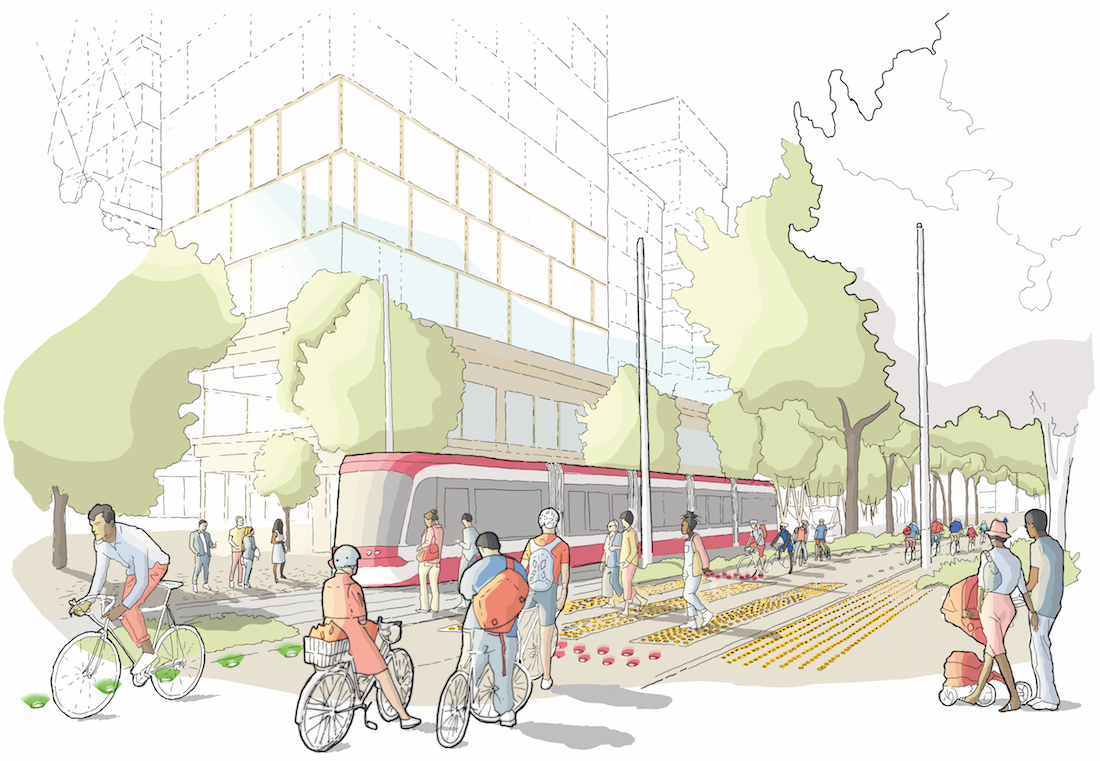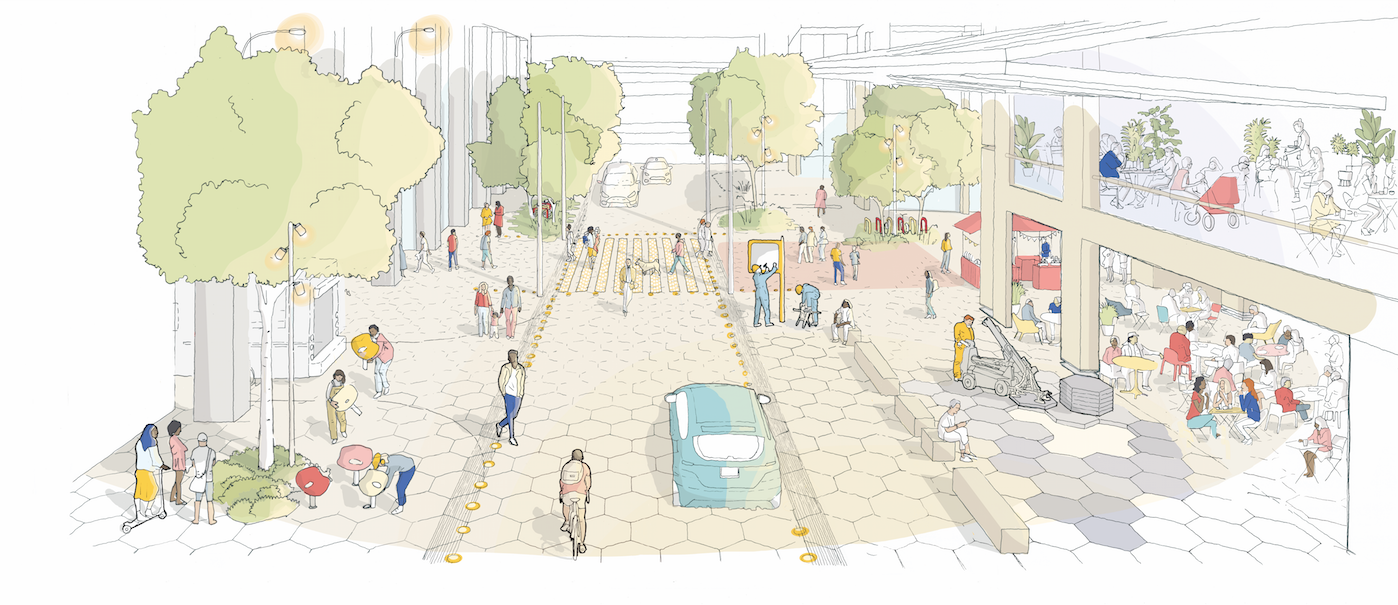
This article looks at plans to “design” safety into Toronto’s streets based on a set of design-for safety principles.
It does indeed stand to reason that the way our city streets are designed to day – for cars and pedestrians mainly – can be improved a lot to integrate the new and emerging forms of individual mobility and surface public transit (trams etc..)
 by Andrew Miller – 31 July 2019
by Andrew Miller – 31 July 2019
Designing safer streets to help Toronto reach Vision Zero
No matter how we’re getting around the city — whether by bicycle, car, streetcar, or on foot — we expect streets to allow us to move quickly, affordably, and safely. Of those three expectations, safety is the most important, and in an ideal world, every trip would have it. There would be no collisions.
But we don’t live in that ideal world, and we Torontonians know it all too well. It’s commonplace here for pedestrians and cyclists to be struck by drivers. It’s such a pervasive problem that our public officials have endorsed a comprehensive plan to address the issue, called Vision Zero.
The guiding philosophy of Vision Zero is that collisions are preventable, always and everywhere, no matter the variety of people sharing our streets. Every incident can be avoided and the number of injuries from collisions can be brought down to zero (hence the name).
Vision Zero thinkers believe that the main reason we have collisions now is because we’ve designed a system that assumes drivers are always going to be on their best behavior. As anyone who has ever driven anywhere can attest, that is not a realistic assumption to make. Instead of designing for perfect drivers, we need to design for all sorts of drivers, and the system we build has to militate against speed and inattention.
It may seem unlikely, but yes, our streets today actually encourage drivers to behave badly. We make our roads straight and our pavement smooth, and we separate the street surface from sidewalks via curbs. The goal of this design is to make the road a simple and predictable environment, and drivers find it so simple to navigate that they are tempted to do so faster than they should — and to multi-task while driving, or even just to pay less attention to the road and more to their own thoughts.
Consequently, when cyclists or pedestrians are also using the space, drivers are often not watching for them. Worse, drivers are traveling so quickly that, even when they do notice other users, they’ve got less time to react, and if there is a collision, the higher speeds do more damage. By making driving so simple, we inadvertently have made it less safe.
These challenges have been on our minds, and we’ve tried to address them in our Toronto Tomorrow proposal released last month. Much of our general thinking was also outlined in our Street Design Principles, released in the spring. Briefly, those principles say that when we’re designing streets, we should do the following to improve safety:
- Tailor streets for different modes
- Separate streets by speed
- Incorporate flexibility into street space
- Recapture street space for pedestrians, cyclists, transit vehicles, and the public realm
Reimagining Queens Quay for 2025
To understand how we propose to apply these principles along the eastern waterfront, let’s take a look at a few of our proposed street designs from Toronto Tomorrow, starting with Queens Quay, the main street running through Quayside. Here’s how it could look in 2025:

And here’s a closer look, with the expected mix of ways to get around for a street of this size: cyclists, transit, and pedestrians, as well as cars:

As you can see from the illustration, we’re proposing several approaches that would help people using the street get where they’re going safely.
First, we’re proposing to implement many of the established best design practices used around the world today for transit and bicycles. For the streetcar, it’s a dedicated lane that keeps it from mixing (and having to deal) with other traffic. For bikes, it’s wider lanes. Here, for instance, the bicycle path is five metres across, allowing easy flow in both directions.
Second, we’re also proposing to use new technology, such as a dynamic crosswalk: LED lights embedded in the pavement that give pedestrians cues on when to cross and when to stop. Regular crosswalks are static. Making them dynamic allows for street crossings to be broken up into shorter segments, enabling people to cross in stages while also helping drivers become more aware of the crosswalk.
This approach achieves a couple goals. Short crossing segments, rather than a single long one, makes crossing safer. That crossing can also be broken up where necessary; in Quayside, for instance, we can ensure that light-rail vehicles always have crossing priority, to keep transit service moving for the greatest number of travelers.
On the bottom left of the image, you will notice a row of green LEDs. That’s called a “green wave,” and it signals to cyclists that they are clear to proceed. Better yet, so long as they synchronize their speed with the rolling wave of green lights, they’ll always reach intersections when they have their own right-of-way, and will never have to stop.
The overall result is that people know where and how to move safely in their environment, no matter how they’re travelling or where they’re going.
Creating a more responsive streetscape with the dynamic curb

One of the most exciting innovations we’ve proposed is called the “dynamic curb.” Today, a curb is a fixed border that separates the street space set aside for cars and other vehicles from the space reserved for pedestrians.
A dynamic curb is rather different. It’s flush with the street, for one thing, much as some streets in Europe are. For another, it’s not fixed in concrete, but moveable.
Together, these changes offer a variety of improvements. The lack of a raised curb makes it easier for people using wheelchairs or other mobility devices to cross. The removal of curbs is another signal to drivers that they are expected to drive slowly and alertly through the space. And finally, the ability to dynamically reassign the border between road and sidewalk allows for active and ongoing repurposing of valuable urban public space.
To illustrate this idea: the following gif represents the same section of Queens Quay. In the first frame, we see a section of street set aside as a passenger drop-off area during peak traffic time. In the second, we see that same section of street off-peak, now being used as pop-up retail space.

Technologies like LEDs embedded in pavement, digital signs, and mobile street furniture (notice that the planters are on wheels) enable quick transformation of the street space from one use to another, while also — like all good street designs — sending clear cues to people about what ways, and at what speeds, a space should be traversed.
The result is that a section of street that would otherwise be dead and empty at off-peak hours can be given new life, without damaging the efficiency of the mobility network or compromising anyone’s safety.
Keeping major streets safe
Queens Quay is what we classify as a Boulevard, a major arterial street designed to be shared by all users, including transit riders, drivers, cyclists, and pedestrians. These are the most challenging kinds of streets to design safely. The principal goal is to find ways to reduce vehicle speed, especially in an area like the intersection of Queens Quay and Parliament Street.
North of that intersection, we propose the creation of a new public space we call Parliament Plaza, while to the south is another public area, Parliament Cove. To move people safely between these spaces, across Queens Quay, the plan proposes that through-traffic — whether bicycle, light-rail vehicle, or car — operate at a maximum speed of 10 kilometres per hour, and respect dynamic pedestrian crosswalks that connect the two public places.
We’re taking a similar, pedestrian-first approach to the design of Accessway streets, pictured below at different times of the day:


Cars still have a place, but much-needed space is dedicated to cyclists and pedestrians. That balance is expressed by the common pavers throughout the space, which signify visually that the whole area is for pedestrians, while the lights show that cars will have a designated area. The lower speed limit here of 20 kilometres per hour — well below the capability of cars but is in the middle of a typical cyclist’s capability — discourages driving while improving comfort for bike riders.
This illustration also shows another use of the dynamic curb, and how “connected” cars might integrate with the streetscape. Connected cars are not self-driving cars — they’re conventional vehicles that use a data connection to “speak to the street” to find information, such as appropriate parking spaces or the local speed limit. Connected cars are coming to Canadian streets in the coming decade, and we want Quayside to be ready for them.
As another deterrent to speeding, this design shows the hexagonal paving stones used throughout Quayside. Nothing invites people to drive fast quite like flat, grey pavement. Changing one basic element of the urban fabric — the street surface — can immediately change people’s behaviour.
None of these proposals would, on their own, create a world where we’re certain to achieve the goal of zero traffic injuries or deaths. But the approach we’re proposing serves as an exciting launch point as we look at the potential of design to address one of the most pressing challenges in city-building: how we get everyone where they need to be … safely.
Andrew Miller is Associate Director of Mobility at Sidewalk Labs, based in Toronto.
View original article at medium.com



Recent Comments